Menu
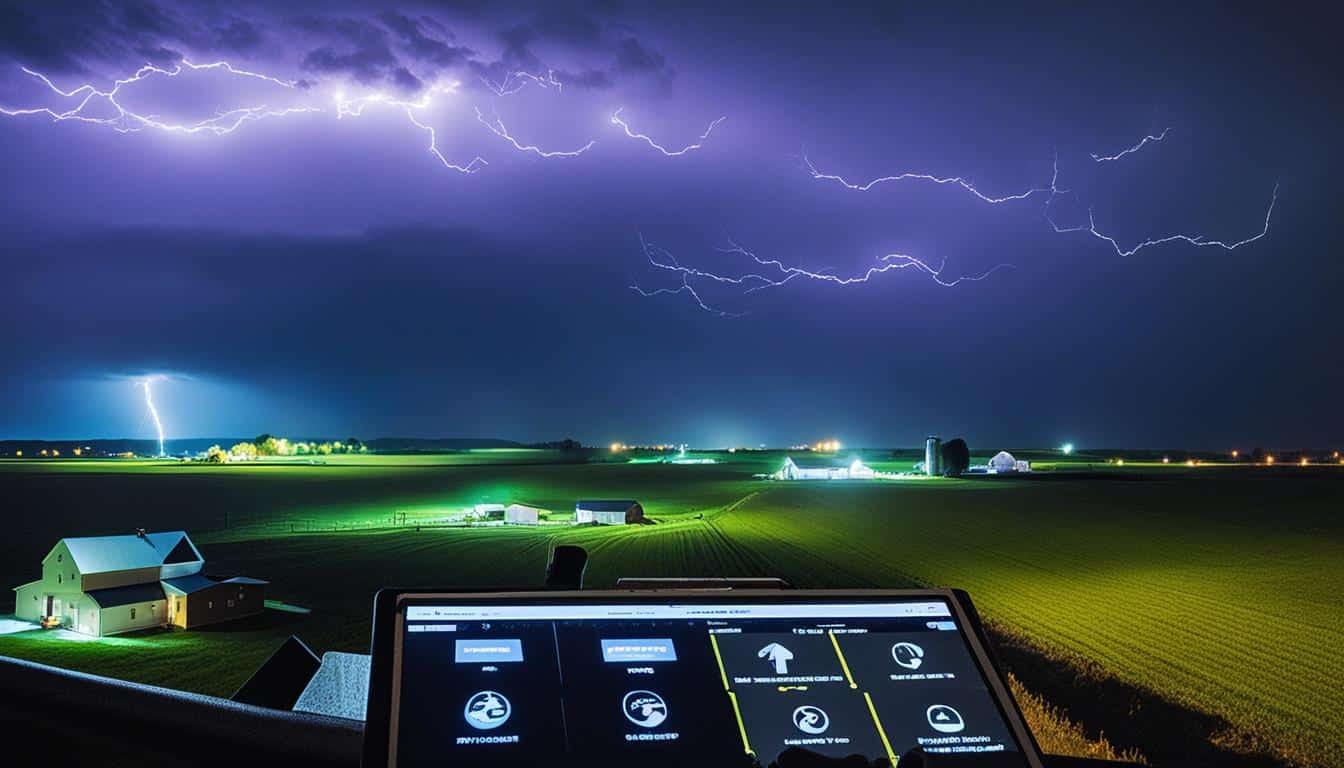
Did you know only around 30% of farms have a full emergency plan? This shows a big gap in being ready for tough times. With plenty of natural disasters like tornadoes, floods, and heavy snow in places like Minnesota, preparing your farm is vital. This planning can help reduce losses if bad events happen.
Emergency plans for farms aren’t just to meet rules; they protect people and animals. A good plan covers everything on the farm, from what you have and where things are, to how to talk to others and work with the local emergency teams. Making a solid plan helps keep risks low and manage big surprises well, safeguarding your farm’s future.
Emergencies can hit farms with little warning, posing various risks and causing disruptions. Every farm should have its own emergency plan. This plan goes beyond just reacting. It includes managing crises to reduce dangers and safeguard what’s important.
Farms face threats like tornadoes, floods, fires, and gas leaks. These can severely affect everything, from animals and crops to equipment and people. A well-thought-out emergency plan means a fast, organised response. This can lessen an emergency’s impact and ensure the farm can continue working. It also helps care for animals and stick to safety rules.
Hazards on farms range from natural disasters to man-made issues. Tornadoes, floods, and snowstorms are natural threats. Each needs a special plan in rural areas. Man-made dangers, like fires and gas leaks, demand detailed plans and using resources wisely for risk control.
It’s vital to heed alerts from the Emergency Alert System and local warning procedures. A clear farm map is crucial for agricultural crisis management. Also, keeping a list of emergency numbers and updating your insurance can help a lot. Having an emergency kit and securing your machinery boosts readiness.
Starting an emergency plan for your farm needs careful planning and teamwork. It’s important to collect the right data and work with local emergency teams. These important steps help prevent hazards on the farm and respond to incidents quickly.
Farmers should gather all data needed to deal with dangers. In places like Minnesota, plans should consider tornadoes, floods, snowstorms, and fires. It’s vital to know what livestock, plants, and equipment you have, and the dangers they might pose. Checking your insurance is wise to make sure you’re protected in emergencies. This work helps you respond well when crisis hits.
To be ready, farmers should prepare emergency kits and teach staff what to do in a crisis. This helps with various emergencies, from health issues to accidents. It’s also key to keep an eye on dangerous gases and make sure protective gear is always used. Such steps go a long way in keeping everyone safe on the farm.

Working closely with local emergency services improves your farm’s response to incidents. Having a contact list with important numbers is essential. This list should have vets, emergency services, and people who can help, including your insurance provider. Quick and clear communication is vital in an emergency.
It’s a must to know local emergency signals and partner with authorities for a strong farm response. Training everyone on the farm helps in an emergency. This ensures that each person knows what to do, saving precious time. In urgent situations, like gas leaks or entrapment, calling 911 right away is crucial.
offers in-depth advice to make your farm ready for any sudden event.
A detailed farm map is vital for any emergency plan. It shows where farm safety rules are. It lists all buildings, roads, and where you find animals and dangerous things.
It’s key to clearly mark all ways in and out on a farm map. These paths help emergency people find places quickly. Farmers must keep these paths clear so help can come in fast.
Knowing where animals and dangers are is very important. This helps stop more problems in an emergency. Make sure to mark where to turn off gas and electricity as well.
It’s also good to include nearby areas in the map. This gives a bigger picture for planning and safety. Remember to update the map as the farm changes. Using short ways to write long words (like AST for Aboveground Storage Tank) can make the map clear and quick to use.
A good farm map is crucial for keeping everyone safe. It fits with a whole plan for dealing with farm emergencies. Making and updating these maps is time well spent. It means help can get there fast if something goes wrong.
Keeping a precise farm inventory is key for emergencies. It ensures nothing gets missed when dealing with a crisis. This list also helps with insurance and recovering what’s lost. Here’s how to put together a detailed inventory:
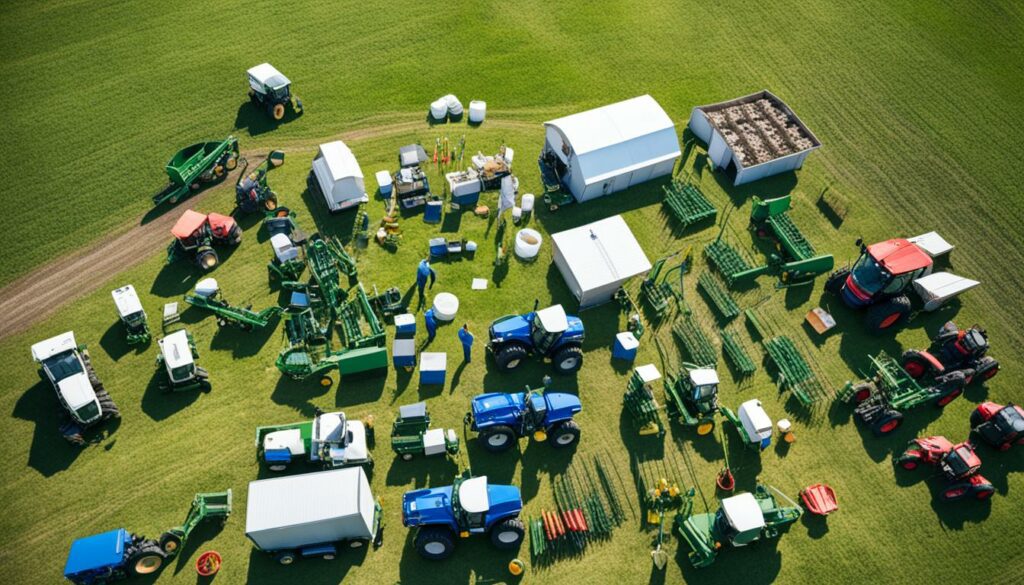
Start your farm inventory by listing all animals and plants. A typical list includes 150 animals, 200 acres of plants, and 15 pieces of machinery. For animals, jot down features like species, age, and special marks. Note the plant type and how much land they cover. This detailed list helps farmers act fast during emergencies.
Don’t forget to record your machines too. Write down serial numbers, when you bought them, and their condition. You should list details for about 15 big machines, such as tractors and harvesters. This info is vital for insurance and quickly fixing or replacing equipment.
Well-kept inventory lists boost emergency readiness and smooth crisis response. Accuracy in logging all items is crucial. It makes the difference in controlling a situation versus facing a chaotic event on a farm.
Making an emergency contact list is vital for any farm. This list ensures quick response and cuts down on crisis time.
Each farm should have a detailed emergency contact list. It must include numbers for vets, the local emergency office, and the farm’s insurance agent. Add the Extension office and other key suppliers.
It’s also important to list utility services and emergency response teams. This way, everyone needed during a crisis is just a call away.
Grouping contacts by the type of help they provide makes finding them easier. It organises the list to be quick and useful in an emergency.
It’s key to update this list often. Fresh contacts prevent hold-ups in an emergency. Teaching farm workers how to use the plan and simulating emergency situations is crucial.
Businesses with a ready-to-go emergency plan recover much faster, around 50% speedier. Being prepared means a farm can face disasters better and get back on its feet sooner.
Keeping contact details up-to-date is a farm’s best bet for a smooth emergency response. Secure these lists but make them reachable for trusted workers. This keeps the information safe and the response effective.
It’s vital to keep your farm’s insurance updated. This ensures you’re ready for any surprises that might hit your business. Also, checking your emergency supplies means you can deal with issues quickly and well.
Start by talking to your insurance agent. It’s good to do this often. They will make sure your policy covers all the big risks farmers face. If your current policy doesn’t cover everything, look into extra plans. Think about what natural disasters, like floods or snow storms, happen in your area.
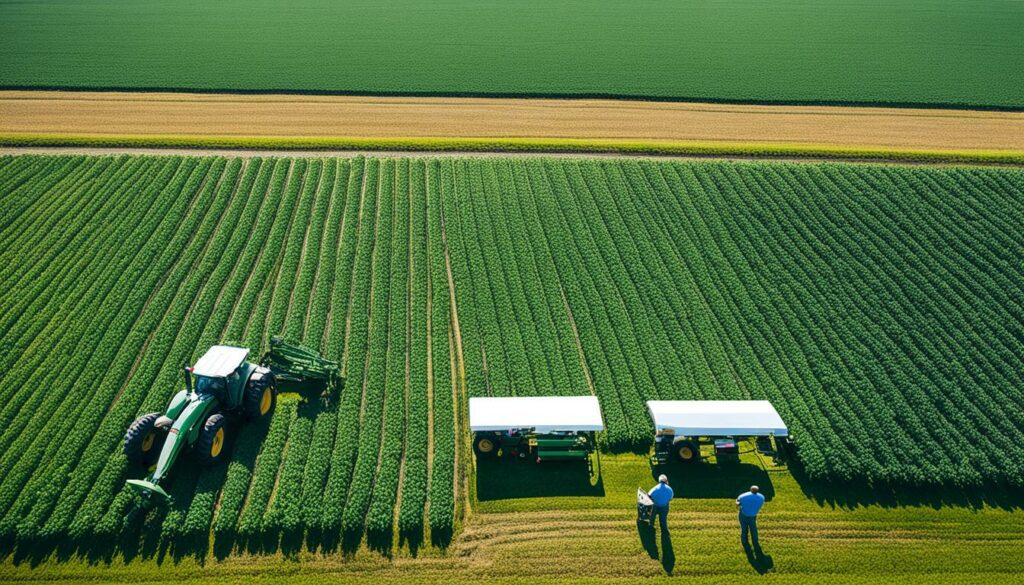
Looking at your emergency supplies is key. Check that your tools, fire extinguishers, and generators are in good shape. It’s essential they work and are ready to use. Keep your farm buildings strong and store dangerous things safely.
Also, make sure your farm workers know what to do in an emergency. Have drills and teach them how to use the equipment. Good communication is crucial. Training your team means your emergency plan will work better when it’s needed.
By keeping both insurance and emergency supplies in top shape, you’re making your farm safer. This way, you’re prepared if something bad happens. It not only helps financially but also makes your farm more resilient in tough times.
Farmers in Minnesota must ready a solid plan for emergencies. This includes facing dangers like tornadoes, floods, or fires. A farm evacuation and shelter-in-place strategy are crucial to keep everyone and everything safe.
Start by knowing your farm’s layout and managing its resources. Draw a detailed map showing buildings, paths, and livestock areas. This helps pick the safest spots to stay. It’s also key to pick closed-off areas to protect everyone from danger.
Be sure to have enough supplies to last through a crisis. Save food for animals, water, first aid, and tools. Keep checking and replacing items so they’re always ready when needed.
A farm evacuation plan must be ready before disaster strikes. Time is of the essence in getting people and animals to safety. Include lists of where to go and how to get there. Also, make sure all workers know the plan by heart.
Don’t forget about the animals and equipment when you need to leave. Make sure everyone knows how to move the animals safely. Keep a list of emergency contacts, like vets and insurers, handy.
Rehearse your farm evacuation plan and safety-in-place plan often. This ensures everyone knows what to do when it counts. Work with local emergency teams for advice and training.
| Keyword | Integration |
|---|---|
| farm evacuation plan | Highlighted as a critical component for emergency strategies involving escape routes and relocation. |
| shelter-in-place strategy for farms | Emphasised in strategies for maintaining safety during isolation and stockpiling necessary supplies. |
Every farm must have a detailed emergency plan, including medical situations. This is key because farms face dangers like heart attacks, allergies, or injuries every day. Farm staff should always have first aid training to handle these issues.
It’s important that everyone working on the farm understands health conditions and their signs. This can change a small problem into a big one very quickly. To be fully prepared, farms need to give their staff first aid training.
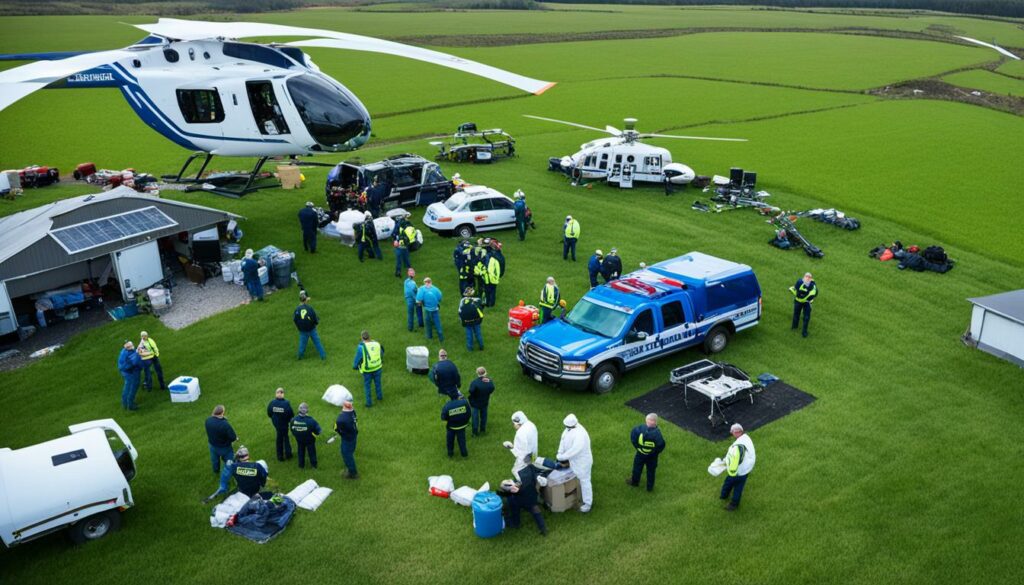
A clear and easy-to-reach emergency contacts list is crucial. This list should have numbers for vets, emergency services, and insurance, among others. Having this info close by helps get help quickly.
It’s also smart to create clear paths for emergency teams, showing all important locations. This is vital in places like Minnesota, where disasters are common. Being prepared for tornadoes, fires, or floods is a must.
Making farm medical plans ahead of time is a big step in staying safe. With the right first aid training, staff can tackle health crises better. This makes the whole farm a safer place.
Emergencies with toxic gases and being stuck in small, closed places are big dangers on farms. Having a plan for toxic gas emergencies and knowing the safety rules for grain bins are vital. These are key parts of keeping a farm safe.
Places like manure pits can be very dangerous. Even though farms don’t follow all the OSHA rules for confined spaces, they are still risky. People have died because they went into these places without right breathing gear. So, making sure the air is safe to breathe is crucial.
Having tools to check the air for gases is vital in an emergency. These tools show if a place is safe to go in. You can rent a tool like this for around $180 a day or $360 a week.
It is essential to call 911 if someone is found unresponsive in a confined space, especially a manure pit.
If you must go into these areas, wear a safety harness. This is attached to a system that can catch you if you fall. It’s very important to keep the air moving in these spaces. This helps with both lack of oxygen and getting rid of toxic gases.
Grain bins are also very risky for getting stuck. Following safety rules can avoid life-threatening accidents. Some people have been trapped trying to loosen grain. It’s key to make sure all machines are off before going in. Everyone should know what to do in an emergency in a grain bin.
and should be checked often to make sure you’re doing everything right and staying safe.
Here’s a brief look at the costs and steps needed for keeping safe in dangerous spaces and dealing with emergencies:
| Safety Equipment | Cost | Preventive Measure |
|---|---|---|
| Multi-gas Detection Meter | $180/day or $360/week | Assessing confined space safety |
| Body Harness and Fall Arrest System | Priced per type and brand | Preventing falls and aiding in retrieval |
By following these plans for handling toxic gas and working safe in grain bins, farm workers can cut many risks. This leads to a safer place to work.
It’s key to make sure everyone on the farm knows what to do in emergencies. Doing safety drills often and talking about safety keeps us ready. This helps us all be careful and ready for anything that might happen.
Having farm safety training often is important. Everyone learns what to do if there’s a fire, a flood, or bad gas. These safety steps are rehearsed, making sure we all know our jobs. This way, we’re prepared when a real emergency happens.
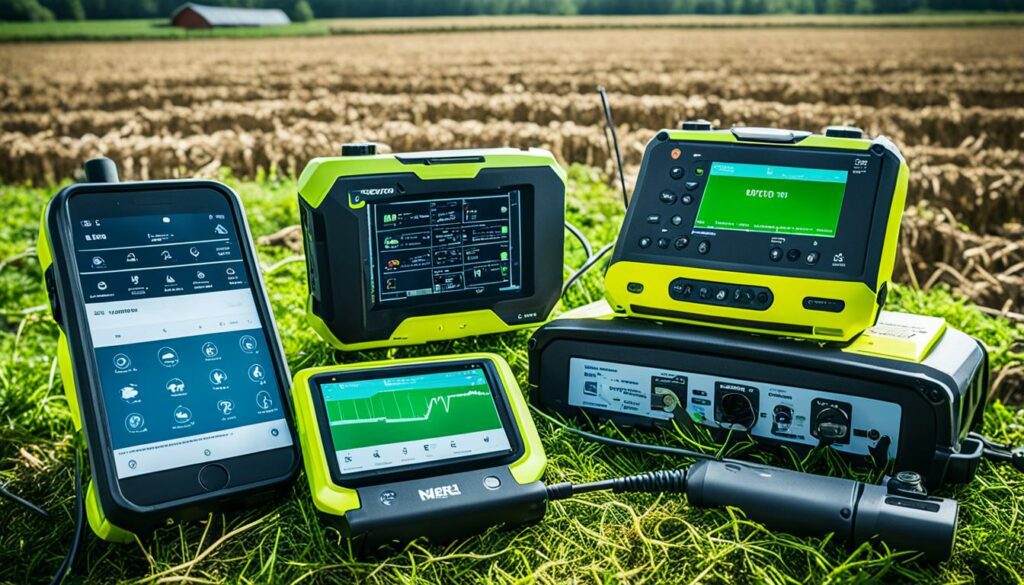
Having good emergency communication strategies is crucial. We set up ways to talk fast if something bad happens, like with radios and phones. We also pick spots to meet up, so we don’t get confused.
Here are some things we do to keep in touch on the farm:
Using these emergency communication strategies with farm safety training makes us better ready for troubles. Each person knows what to do. This makes sure we all help each other, even in scary times.
It’s vital to use emergency resources effectively to handle farm crises well. This involves relying on help from government initiatives, farm programs, and local community services. By doing so, a farm can better face emergencies and come out stronger.
Every business, including farms, needs a plan for when disaster hits. For farms, this means focusing on five essential areas: Emergency Contacts, Animal Care, Staff Management, Resource Gathering, and Maintaining Market Activities. Each of these parts needs a careful plan to ensure the farm is ready and can respond quickly in tough times.
To make the best use of help available, the first step is to build a list of emergency contacts. Include people who can make decisions if you’re not available. And make sure everyone knows their roles to keep the animals safe and healthy, covering everything from feeding to cleaning shelters.
When it comes to handling work during emergencies, you must know what work needs doing and who can do it. That includes having backup plans and making sure someone else knows how to run things if the usual person can’t. It’s also essential to have plans in place for getting what you need, like food for animals or medical supplies, quickly.
| Management Area | Key Considerations | Required Resources |
|---|---|---|
| Emergency Contacts | Decision-making, Availability | Contact Lists, Communication Tools |
| Daily Animal Care | Feed, Watering, Ventilation | Feed, Watering Systems |
| Labour Management | Training, Familiarity | Training Manuals, Roster Management |
| Obtaining Resources | Feed, Medicines, Supplies | Supplier Contacts, Inventory Systems |
| Market Operations | Business Continuity | Market Analysis, Contingency Plans |
Keep a stock of key medicines and first aid items ready for medical emergencies. Plan your feed and supplies well, so there are no shortages. Be skilled in using important equipment like generators and tractors by training regularly and having clear guides.
Also, be ready for losing market connections in case of disasters or sudden shutdowns. Knowing what’s crucial and having plans and resources ready is key. This, combined with FEMA’s support, ensures farms can overcome any crisis.
Creating a strong farm emergency plan isn’t easy but is very necessary. This includes careful making, regular checks, and everyone’s help. With natural disasters getting worse because of climate change, farmers need to be ready. A good and often updated plan helps a lot in dealing with crises. It keeps people and animals safe and helps lessen money and work losses.
Knowing the dangers rural areas face, like floods, storms, and fires, is key. Work with local groups to make action plans that fit your needs. Things like livestock counts, planting times, and insurance papers are very important. They help a lot in dealing with and recovering from disasters.
Thinking about mental health after a disaster is also very important. Community and mental health care help a lot in tough times. We can learn from past disasters to get better at responding in emergencies. Using national and local help, like the Colorado Agriculture Department’s resources, can make farmers more ready for what might come.
Having a good emergency plan helps farmers stay ready and deal with disasters better. It supports farm life, keeps people safe, and builds strong communities. By always getting ready and improving, we make farming safer for everyone.
A farm emergency response plan is key. It helps lessen risks and handle unexpected events well. This ensures everyone – humans and animals – stay safe.
By getting ready for different problems, farms lower the impact of accidents. They also stay operational, which is crucial for their business.
On a farm, many risks can lead to emergencies. These include tornadoes, floods, and snowstorms. Also, fires and toxic gas events are real dangers.
It’s important to prepare for these. It helps manage crises well and keeps the farm safe.
To start, you gather info on possible dangers. Then, you should make friends with local emergency services. Next, learn about local warning signals.
Also, create emergency kits and train your team how to act. These steps are the foundation for a good emergency plan.
Your map should show where everything is. This includes buildings, roads, and where you keep livestock and dangerous materials.
It must also point out where to turn off electricity and water. This helps your team and emergency crews stay safe.
An inventory list is a lifesaver in emergencies. It helps manage resources, make insurance claims, and start recovery.
Include things like livestock types, crop amounts, and machinery info. This ensures a smoother emergency response.
Put important numbers in your contact list. This includes vets, local emergency teams, and your insurance agents. Also, add suppliers and service teams who help run your farm.
Having this list means everyone can be reached quickly during a crisis.
Keep checking your insurance with a professional. They will help you understand what you need for different emergencies.
Update your policy as needed. This ensures your farm is well-protected.
A good plan includes knowing how to stay safe where you are and when to leave. It also should say how to manage your resources while you wait for help.
Make sure everyone knows the escape routes for both people and animals. This keeps everyone safe and reduces the emergency’s impact.
It’s vital to train your team in first aid. Make sure they know the signs of health problems. And keep an updated list of emergency contacts.
These steps can help save lives in a medical emergency.
Have the right tools to monitor gas levels. Make sure your team is trained to act in these situations. And have a clear plan to follow.
Remember, in such cases, call for help and wait for professionals. These events are very risky, so safety comes first.
Regular quick drills and good communication keep everyone ready. It makes sure your whole team knows what to do. This builds a culture of readiness and helps in actual emergencies.
Farms can get help from government programs, agriculture services, and the local community. They offer useful information and support. This strengthens a farm’s ability to deal with crises.